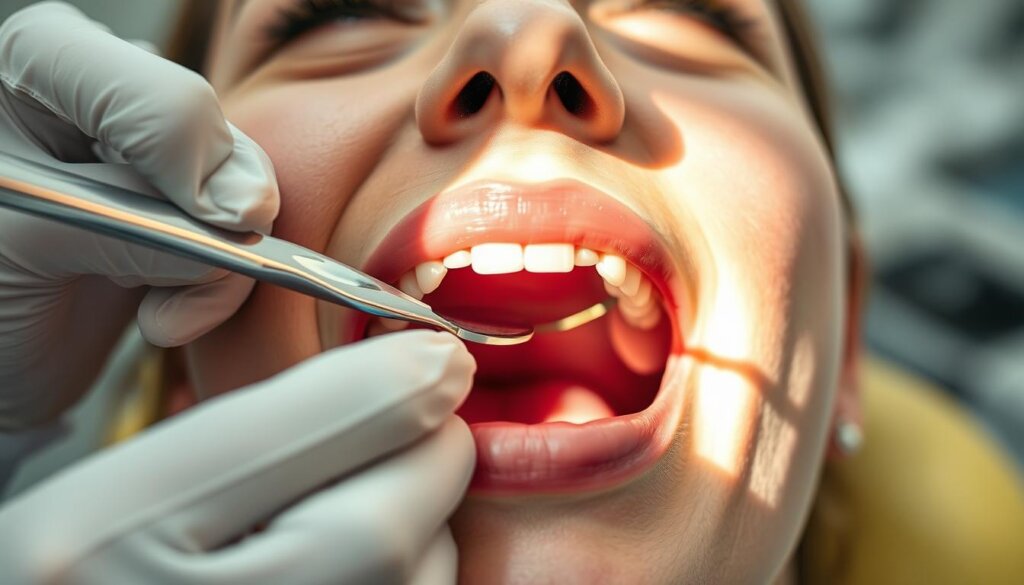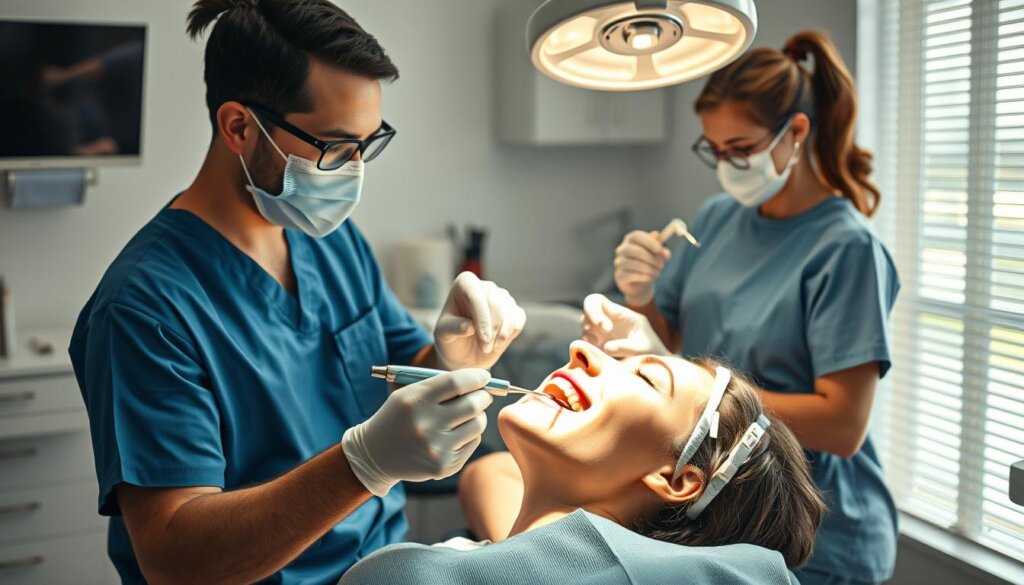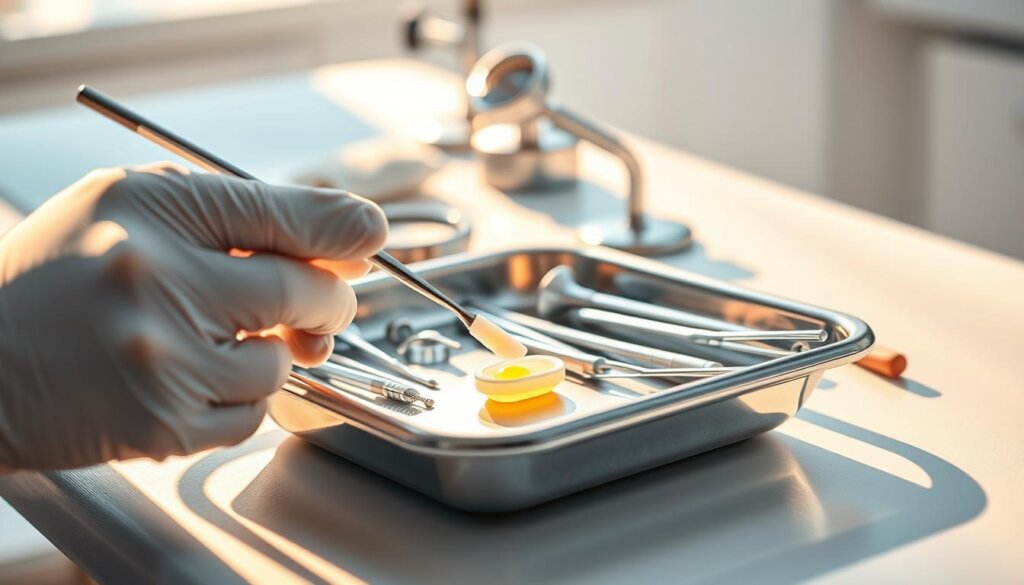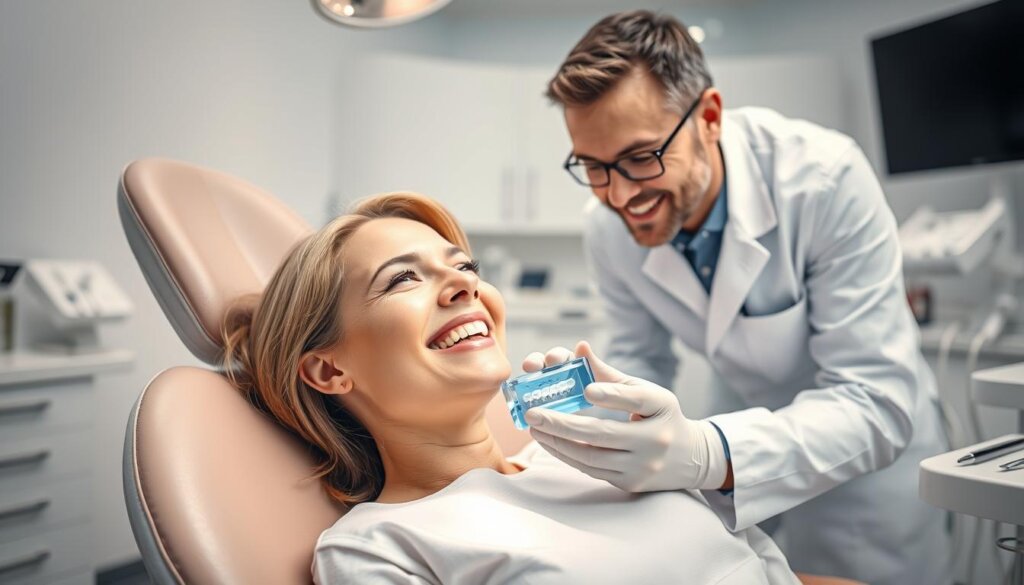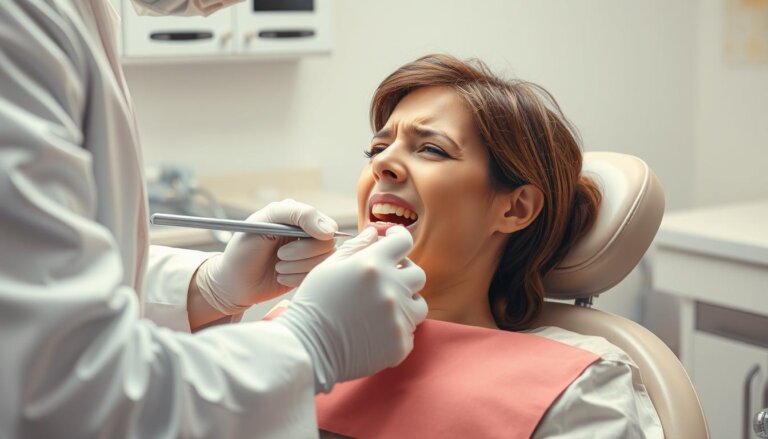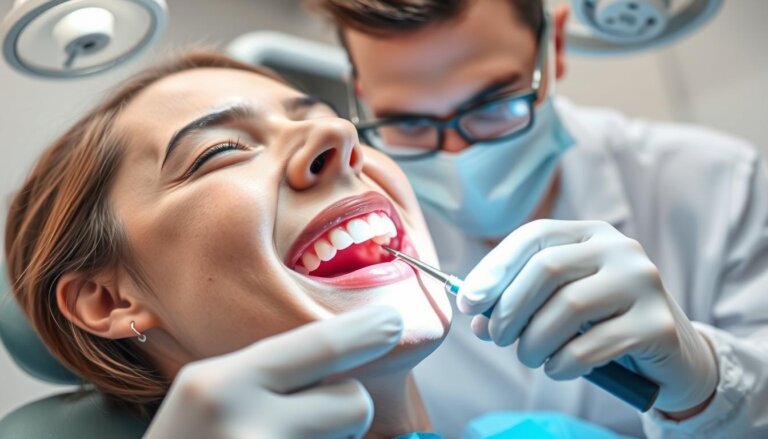Dental Cleaning Procedure: What’s Involved?
Did you know nearly one in every four adults have untreated dental caries? This fact from the Centers for Disease Control and Prevention highlights the importance of oral hygiene. Understanding the dental cleaning process is crucial for keeping your mouth healthy. “What does the dental cleaning procedure involve?” This question leads to knowing how to remove dental plaque and keep your teeth healthy.
The dental cleaning process is more than just for a brighter smile. It’s a series of steps to keep your teeth and gums healthy. Unlike simple brushing, professional teeth cleaning uses advanced methods to remove plaque and tartar. This is essential for maintaining top-notch oral hygiene in our community.
If you’re scared of going to the dentist, there’s good news. Modern offices offer sedation dentistry to help ease anxiety and stress during cleanings. Talk to your dentist about making cleaning a key part of your health routine. With regular professional cleanings and daily home care, you can prevent many oral diseases.
Key Takeaways
- Understanding the scope of professional teeth cleaning and the steps involved.
- The link between regular dental cleanings and overall oral health maintenance.
- Strategies for addressing dental anxiety and ensuring a comfortable cleaning experience.
- The role of professional teeth cleaning in dental plaque removal.
- Emphasizing the necessity of consistent oral hygiene practices both at home and professionally.
Understanding Dental Cleaning Procedures
Dental cleanings are more than just for a bright smile. They’re key for keeping gums healthy and preventing diseases. Learning about these cleanings shows their role in oral health.
Importance of Regular Dental Cleanings
Getting your teeth cleaned regularly prevents gum disease and tooth decay. These cleanings take away plaque and tartar that brushing and flossing can’t. They help keep gums healthy and lower the chance of future dental problems.
Frequency of Dental Cleanings
Most people should get a dental cleaning every six months. But, how often you need one can change. Your oral hygiene, dental history, and health decide your cleaning schedule. Dentists tailor this to best protect your oral health.
Who Performs Dental Cleanings?
Dental hygienists usually do these cleanings. They’re trained to focus on preventing oral issues. They remove plaque and tartar to prevent gum disease. They also teach you how to take care of your teeth at home.
Knowing about dental cleanings can make you less anxious about dentist visits. Regular check-ups are good for both your oral and overall health. Taking part in these cleanings is important for long-term health.
Preparing for a Dental Cleaning
Getting ready for your dental appointment is key. Knowing about the dental cleaning process helps a lot. It makes sure the cleaning goes smoothly for both you and the dental team.
Understanding what happens at the dentist can ease any nerves. It’s important to know what the visit involves. This helps you give your dentist all the info they need for your health.
- What to Expect Before Your Appointment
- Confirmation of appointment details and time.
- A brief overview of the procedure from the dental office.
- Instructions on oral hygiene or eating habits prior to the visit.
- Necessary Medical History Information
- Detailed discussion of past dental and medical history.
- List of current medications and any known allergies.
- Information on any recent surgeries or changes in your health.
It’s really important to give accurate medical history. This info shapes your dental cleaning process. It prevents problems during the cleaning. Some health issues can change how you react to treatments. A well-informed dental team means a safer, more effective cleaning.
The Initial Dental Examination
An initial dental examination is key for keeping your oral hygiene on track. It includes various checks to spot any dental health problems. This exam sets the stage for cleaning your teeth and other dental treatments. It makes sure you get a full care plan that meets your unique needs.
Visual Examination of Teeth and Gums
A detailed look at your teeth and gums starts the process. A dentist or dental hygienist uses a mirror to check for issues. They look for signs of cavities, gum inflammation, and other problems. Spotting these early leads to better treatment.
Digital X-rays and Their Role
Digital X-rays are vital in today’s dental care. They let dentists see parts of your mouth that can’t be seen otherwise. These images help find hidden problems like bone decay and impacted teeth. They are fast and safe, making them key for checking your teeth. Digital X-rays are often part of regular dental exams.
| Procedure | Purpose | Frequency |
|---|---|---|
| Visual Examination | Identify visible oral health issues | Each visit |
| Digital X-rays | View underlying dental structures | Annually or bi-annually |
| Dental Cleaning | Remove plaque and prevent gum disease | Bi-annually |
These thorough exams make sure all oral hygiene problems are caught early. This stops small issues from becoming big ones. Going to the dentist regularly is crucial for healthy teeth.
The Actual Cleaning Procedure
Dental scaling and polishing are key to keeping your mouth healthy. They make sure your teeth and gums are in top shape. The cleaning process includes scaling to start, then polishing, and ends with flossing. Each step tackles plaque to keep your teeth clean and looking good.
Scaling: This first step removes plaque and tartar from your teeth and gums. It’s vital for stopping gum disease and tooth decay caused by tartar and plaque.
Polishing: After scaling, your teeth are polished. A strong brush and special toothpaste remove any remaining tartar. This leaves your teeth clean, smooth, and shiny. It also helps prevent more plaque from forming in the future.
Flossing: Flossing is the last step. It gets rid of particles stuck between your teeth. It also shows where you need to brush more at home.
| Procedure | Purpose | Benefits |
|---|---|---|
| Scaling | Remove plaque and tartar | Prevents gum disease and tooth decay |
| Polishing | Remove leftover tartar and smooth teeth | Teeth appear cleaner and smoother, reducing future plaque build-up |
| Flossing | Remove lingering particles | Highlights areas needing more attention in daily care |
In short, scaling and polishing are must-dos in dental care. They ensure your teeth are clean and contribute to lasting oral health.
Post-Cleaning Evaluation
After your teeth get cleaned by a dentist, there’s an important step called the post-cleaning evaluation. It’s not only about looking at the results but also planning how to keep your teeth healthy every day. This step helps connect what the dentist does with what you do at home.
During this time, you can talk about how the cleaning went with your dentist. This talk is key. It lets you know about the health of your teeth and gums. It also points out any issues that might need extra care.
Then, your dentist will give you custom tips to help take care of your teeth. These tips are based on the newest dental studies. They help you keep your teeth in top shape until your next visit.
Some advice might include:
- How to brush or floss better
- The best products for your teeth
- Food choices that affect your teeth
Cleaning your teeth at the dentist and getting feedback is about more than just a clean mouth. It’s about improving how you take care of your teeth at home. By listening to your dentist’s advice, you can keep your teeth healthier. This can help you avoid cavities and gum disease. With good habits, you can make sure your smile stays bright.
The Role of Fluoride Treatment
After cleaning your teeth, dentists often finish with a fluoride treatment. This step is key for keeping your mouth healthy and protecting against cavities. Adding fluoride treatments during your visit strengthens your teeth and cuts down on the need for more dental work later.
So, what happens when you get fluoride during a dental visit? A foamy gel or a thick paste with fluoride is put on your teeth. This can be a varnish, foam, or gel that sets fast when it touches your spit. Because it hardens quickly, you can eat and drink right after without swallowing the fluoride.
Fluoride is a proven fighter against cavities, playing a vital role in dental health. Getting fluoride regularly helps make the tooth’s enamel stronger. This reduces cavities and slows down the start of tooth decay.
But fluoride treatment does more than just help now; it guards your teeth against future problems too. It creates a barrier against the usual causes of tooth decay. With fluoride, your teeth stay healthier and stronger for the long haul.
Addressing Common Concerns
The topic of dental cleaning discomfort and allergies to dental products often comes up during dental visits. Such concerns are very important to both patients and dentists. Thankfully, through careful attention and personalized care, these issues are well managed.
Many people feel nervous about the possibility of pain during dental cleanings. Dentists use gentle methods and the latest tools to keep discomfort low. For those with sensitivities or allergies to dental products, dentists follow specific steps to make sure everyone has a safe, pain-free visit.
| Concern | Approach | Benefit |
|---|---|---|
| Dental Cleaning Discomfort | Use of gentle techniques and pain management options | Reduces anxiety and enhances patient comfort |
| Allergies to Dental Products | Utilization of hypoallergenic products | Prevents allergic reactions and promotes safe treatment |
Talking openly with your dentist is key. If you share your past experiences of discomfort or allergic reactions, your dentist can adjust their approach. This way, they make sure to meet your specific needs in a careful and effective way.
Additional Services Offered
Besides standard dental cleaning and exams, many places offer more to help your teeth look and feel good. Dental sealants and professional teeth whitening stand out for their benefits and how popular they are.
Dental sealants help prevent cavities, not just for kids but adults too. They cover the molars to keep decay-causing stuff like plaque and food out.
Professional teeth whitening makes your teeth much brighter. It’s a favorite choice for those wanting to look their best, for their personal life or at work.
| Service | Description | Benefits |
|---|---|---|
| Dental Sealants | Protective coating applied to the chewing surfaces of back teeth. | Prevents tooth decay and cavities, especially in children. |
| Professional Teeth Whitening | Application of high-grade whitening agents under controlled conditions. | Delivers faster and more effective results than over-the-counter methods. |
Dental sealants and professional teeth whitening do more than just keep your teeth clean. They help keep your mouth healthy and make you feel good about your smile. Whether it’s protecting your back teeth or making your smile shine, these services make a big difference.
Special Considerations for Children
Starting pediatric dental care early is key to good oral health for life. These visits are crucial. They not only prevent dental problems but also make the dentist a friendly face for kids. This helps children see dental care in a positive light.
These early appointments do more than just take care of teeth; they shape how kids feel about dental health. We’ll look at why these cleanings matter and how to make them stress-free.
Importance of Pediatric Dental Cleanings
Regular cleanings are essential to stop cavities and tooth decay, which hurt kids’ health. At these visits, kids learn the right way to brush and floss. Early care keeps gums and teeth healthy and spots problems early.
Tips for Making Dental Visits Easier
- Starting dental check-ups early helps kids feel okay at the dentist’s office.
- Talk about dental visits in a happy way. Keep your worries to yourself.
- Pick times for appointments when your child is usually happy and calm.
- After the visit, a small treat can make them look forward to the next one.
Using these ideas to make dental visits fun can turn scary times into fun learning moments.
The Impact of Dental Cleanings on Overall Health
Dental health is about more than just a bright smile. It’s deeply linked to our overall well-being. Regular dental cleanings are key in preventive dental care. They help keep the mouth healthy and check on overall health status too.
Link Between Oral and Systemic Health
Our mouth health shows a lot about our body health. It opens a window to our body, catching early signs of diseases. Problems like diabetes and heart disease can show up in our mouth which dentists spot during cleanings.
Dental Cleanings and Preventive Care
Dental cleanings do more than clean teeth; they safeguard our health. Dentists check for things like swollen gums during these visits. This can point to issues elsewhere in our bodies, making cleanings a key health check.
- Early Detection: Visiting the dentist regularly helps spot signs of bigger health problems early on.
- Education on Oral Hygiene: Learning about good oral care is crucial in preventive dental care.
- Encouragement of Consistent Care: Keeping up with dental cleanings helps stay on top of overall health too.
Putting dental health as part of total health care is important. It helps us see the big picture of keeping healthy. Highlighting the systemic health connection shows why preventive dental care matters in taking care of ourselves.
What to Do After a Dental Cleaning
After getting your teeth cleaned, it’s key to take good care of your smile. We’ll share tips on post-dental cleaning care and what foods to steer clear of. This helps keep your teeth healthy and clean longer.
Keeping your mouth healthy after a cleaning needs daily effort. Dentists suggest a few key steps:
- Brush your teeth twice a day with fluoride toothpaste to prevent plaque buildup.
- Floss daily to remove debris from between the teeth where a toothbrush can’t reach.
- Use an antibacterial mouthwash to kill bacteria that might cause plaque and bad breath.
Your diet is also important right after a cleaning. Certain foods can hurt your teeth or stain them.
| Foods to Avoid | Reason to Avoid |
|---|---|
| Hard candies or foods | Can cause mechanical damage to teeth |
| Beetroot, red wine, coffee, tea | Can stain your freshly cleaned and polished teeth |
| Very hot or very cold foods | May cause discomfort due to temporary sensitivity after cleaning |
Stick to these post-dental cleaning care tips and watch your diet. This will make your cleaning last longer. Following oral hygiene best practices improves not just your teeth but your whole health.
Scheduling Your Next Appointment
Keeping a schedule for regular teeth cleanings is key to keeping your teeth healthy for a long time. Knowing when to have these cleanings and how to easily book them helps a lot with your oral health care.
Dentists usually say you should get dental cleanings every six months. Doing so helps stop gum diseases and keeps your smile looking great. Thanks to new dental office tools, making a dental appointment is easier and faster than before.
Here’s a table showing the old way and new way of booking dental visits:
| Booking Method | Convenience | Availability | Preferred by |
|---|---|---|---|
| In-Person/Phone | Personal Interaction | During Office Hours | Less tech-savvy patients |
| Online | 24/7 Availability | Always Open | Tech-savvy individuals |
Picking how you schedule your dental appointments depends on what you like and your daily life. Whether you enjoy talking to someone or the ease of booking anytime, sticking to a schedule for regular teeth cleanings is very important.
Conclusion
Dental cleaning is very important for keeping your mouth healthy. It starts with a close look at your teeth and gums, using both eyes and digital X-rays. Then, tough plaque and tartar are removed through scaling. Teeth are also polished and flossed for a thorough clean.
After that, fluoride treatments help protect your teeth from decay. This complete cleaning process is key to keeping both your mouth and your whole body healthy.
Summary of the Dental Cleaning Process
Every part of the dental cleaning process is crucial for protecting your oral health. It begins with the steps you take before going to the dentist and includes advice given after your cleaning. This whole process helps stop dental diseases and keeps your teeth healthy for a long time. Going to the dentist is like making a promise to keep yourself healthy.
Encouragement to Maintain Regular Dental Appointments
Keeping up with dental visits is very important. These visits help find and fix problems with your teeth and gums early. By going to regular check-ups, you are doing something important to prevent dental problems. You’re also laying a strong foundation for your overall health and well-being.
Therefore, it’s advised to keep seeing your dentist regularly. This professional care, along with good personal habits, helps maintain a strong and healthy mouth.

